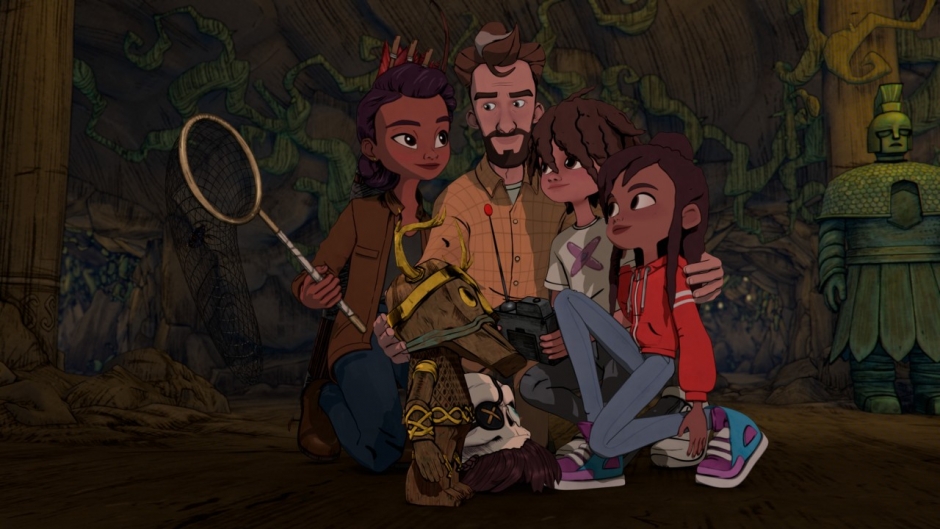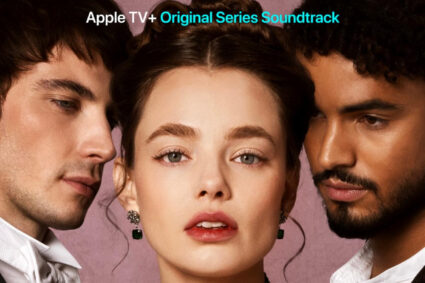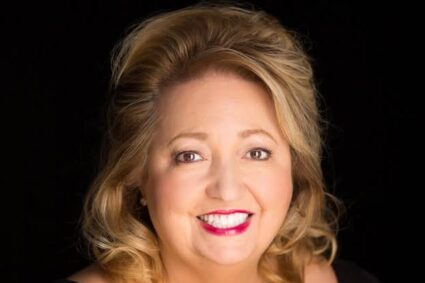
On this October edition of SNAPSHOTS, we are starting our first of two interviews for the upcoming sophomore season of Apple TV+s animated series of CURSES! which premieres tomorrow!
“CURSES!” follows Pandora, Russ and Sky Vanderhouven, a family cursed by their ancestors’ pillaging of ancient artifacts from across the globe in which the father, Alex, was turned to stone. After reversing the curse on an adventure of a lifetime, the second season picks up with Alex rejoining the family as they continue working to undo the damage done by their greedy ancestors. But when something about Alex doesn’t seem quite right, the family must band together to solve the mysteries that confront them, both on the road and within the walls of Briarstone Manor.
In my first interview, I sat down to talk with the creator/executive producers Jim Cooper & Jeff Dixon to talk about what they enjoy about the horror genre, bringing the genre to families and having horror legend Robert Englund on the series.
Jim and Jeff, what were your favorite moments from the first season, the freshman year?
Jim Cooper (JC): Oh, wow, that was a curveball I was not expecting. Man, there are really so many, I will tell you the not specific ones, the ones that I enjoyed the most were ones that ended up being different than the show that was in my head, like little kid, like actors putting a turn on a phrase, or, you know, the way the show looked was actually even different than I had initially imagined. So, the first season for me, the excitement was all about seeing it come to life.
Jim Dixon (JD): I’ll give a very specific answer to season one, because it was so fulfilling to me. I was able to watch it a few different times with different groups of kids, like friends, family members or whatnot. And specifically, the Japanese painting episode with the paribo, there’s a few moments where it comes out of the painting, or there’s a few things where these kids jumped higher than I think they’ve ever jumped in any sort of media in their life.
And I was thinking to myself, you know, I’m a big horror nerd, and I was thinking back to those moments when I was a kid of what were some of those, like, scares or specific moments that turned me into the horror person that I am. There’s this little part in my head that, like, “did that episode just create a horror fan for life?” You know what I mean. So, I hope, I think, for me, that specific episode, and a few of those scenes, and thinking, I think I may have just created a horror fan that, to me, was the most fulfilling.
Absolutely, in fact, you gave me a great segue, Jeff. I’m going to turn it over to Jim for this question. Since he talked about what horror speaks to him. Jim, I want to know how this horror speaks to you.
JC: You know what, it’s funny. We’ve talked about the different things that we love about like horror. I’ve always loved the creepiness, the general unsettled feelings involved in horror. And so, my favorite moments of the seasons are when things feel incredibly uncomfortable, more like the tension, even more so like than the jump scare. And so, we were talking about one of the things we’ve both been so pleased with the show is the atmosphere and the vibe, like things that just feel slightly off, and that’s been the most fun to me in creating those moments, because they’re not the obvious ones.
Oh yes, absolutely in fact, the visuals look great in multi art style. It’s the perfect amount of spooky, but it’s never too scary. How was it working collaterally together to create and really nail that unique look that the series has? I mean, it feels a little bit more like something I would see back in the 1980’s when I was a young kid.
JD: Honestly, very much. We had many conversations early on and about 2D/3D, what do we do, you know, that kind of stuff. And Leo Riley, our supervising director, and David Chung, our art director, came to us with this idea of using, kind of an homage to EC comics from the 50s, Tales from the Crypt, Vault of War, using some of these shading methods and some of this. And it was honestly like they were in our brains, because, like we, like those comics are beloved, and so they, they absolutely leaned into that and so, but so it’s using the 2D but set in a CG. So, we actually have jokingly called it 2 1/2D because it’s kind of right in the middle. And especially even the production, there’s a lot of 2D art actually in there that you may not even realize. So there, there is a both CG and 2-D flare and honestly, David and Leo give all the kudos in the world to them.
Now we’re about to proceed with Season 2, wow do you choose the right stories to pick it up a notch for the people who are about to enjoy the next ten episodes?
JC: Well, it was funny that you said it, because we really did look at the season going, “Okay, what did we learn from season one? And how do we make it bigger” and look at, what are things that we did, and how do we not repeat ourselves? So, we would look at the general concept of an artifact of the story, but also, as Jeff would always like to say, “where’s the scares in it,” but specifically what kind we didn’t want to repeat the same kind of scares. So, if there’s a monster thing being scary, the next one has to be different and how, and so that involved really a lot of planning and really kind of thinking about the season as a whole.
JD: I’ll also say one of the things that really helped with season two is, the trust that we all built in season one. And I’m not just saying creatively, but I’m also saying from production and the executives in the studios, like we all were doing a little bit of untested territory. I think in season one, we’re like, “is this going to be too scary? Is it not going to be scary enough? Is it?”
So, we were trying to find that balance. And so, you have to build trust and a relationship. And I think by building that trust, they go, okay, we’re going to let you guys push it a little bit more. And so, we were able to put in a little bit more scares, a little bit more things that, even things story wise, that might be a little bit more adult or something. We were able to push some things that I think only got there because of that trust that was built from season one.
Since we’re in Halloween season he got the master of Halloween, Robert Englund aka Freddy Krueger, in your series. And I believe he’s in season two. So how in the world that you get such a horror icon into this series?
JC: Begging, no dreams.
JD: I mean, what can you say about Robert? He’s kind of like the king of horror. So, like, to me, personally, it was an absolute dream come true. I mean, I remember, I had this photo of him when, like, 15 years ago or more, at Comic-Con, and thinking, this is just like this icon, and now we’re working with him. So, I mean, the short, the real answer to that is DreamWorks casting, bless them, because they, they were able to really manage that. But he was always on our dream list too. And that is not a nightmare joke, that is literally.
JC: The other thing too is like he really is a horror fan, yeah, and he is a fan of the concept of the show. So, it was really exciting meeting the first time where he had ideas and he had done his homework, and he was excited to get in there and do that, and you’re like, that was so exciting. Because it wasn’t just like, “hey kids, I’m here, you got me”. It was like, let’s get to work. Let’s, you know, make this great. And it was so much fun to record him and to hear his ideas, and, you know, play around, because then you’re like, going, “Oh, this is him giving us years of experience of what works so that we’re like, we’re going to trust you.
Now my last question is this, if you tell the person who’s never seen season one to get ready for season two, what would you say to them to prepare for this upcoming season on Friday, what would you say to them?
JD: First thing I’d ask is, “why haven’t you seen season one yet?” And please go watch season one. No, I think honestly, the thing is, is, yes, we went bigger batter everything with the second season, but the core of the show is the same. You’re still, you know, basically looking at it as basically Indiana Jones and reverse and we always wanted to keep the focus on the family. It’s still a family. There’s the whole show really, is about empathy, not just from people’s point of view, but also looking at things from the artifacts’ point of view or the people you know. It’s not just horror or anything. It the first season, second season, both. Its family focused and empathy focused.
JC: You know it’s but even if you haven’t seen the first season, I do think you can enjoy the second season, like there would be things that you’re like, “Oh, I’m intrigued. What’s going on with this.” But all cursed artifacts have a pass to them that you’re trying to figure out. So, I mean, honestly, you. In a weird sort of way, like you could watch the second season and figuring out what happened beforehand would be part of that, figuring out what’s going on, because every episode, you’re having to figure out something new.
JD: Anyways, I was just thinking that if someone’s watching the second season, and Hank comes in, who is basically a character completely composed of blacksmithing tools, they’d be like, “wait, what? Who? Why?” Like, I think they would want to go back and find out who he was and why he’s now part of this season.
CURSES Season 2 begins tomorrow on Apple TV+


